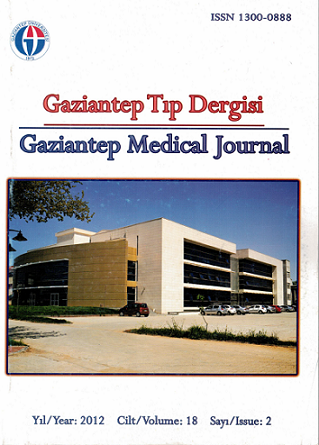The role of human papillomavirus-16 and matrix metalloproteinase-9 in pathogenesis of uterine cervical neoplasia
Uterus servikal neoplazi patogenezinde insan papillomavirüs-16 ve matriks metalloproteinaz-9’un rolü
DOI:
https://doi.org/10.5455/GMJ-30-2012-82Keywords:
HPV-16, invasion, matrix metalloproteinases, metastasis, uterine cervical neoplasiaAbstract
Uterine cervical neoplasia is a major health problem, and can be a leading cause of death. There is strong evidence that human papillomavirus (HPV) is the principal etiological agent in cervical neoplasia. The objective of this study was to investigate the correlation between HPV-16 and matrix metalloproteinase-9 (MMP-9) and uterine cervical neoplasia. Twenty six formalin fixed, paraffin embedded specimens from patients with uterine cervical neoplasia from teaching laboratories in Baghdad city, were included in this study. In addition fifteen apparently normal cervical tissue blocks have been obtained from patients undergoing hysterectomies for sustained uterine bleeding used as control group. In situ hybridization analysis was performed with cDNA probes to HPV-16 and MMP-9. The expression of HPV-16 and MMP-9 in uterine cervical neoplasia cases in the present study was 50% and 61% respectively, but relationship was not found between expression of HPV-16 and MMP-9 and uterine cervical neoplasia. In conclusion, HPV-16 and MMP-9 may have an essential role in progression of uterine cervical neoplasia.
Metrics
References
Pahler JC, Tazzyman S, Erez N, Chen YY, Murdoch C, Nozawa H, et al. Plasticity in tumor-promoting inflammation: impairment of macrophage recruitment evokes a compensatory neutrophil response. Neoplasia 2008;10(4):329-40.
De villiers EM. Relationship between steroid hormone contraceptives and HPV, cervical intraepithelial neoplasia and cervical carcinoma. Int J Cancer 2003;103(6):705-8.
Brooks GF, Carroll KC, Butel JS, Morse SA, Mietzner TA. Jawetz, Melnick, and Adelberg's Medical Microbiology 24nd Ed., The McGraw-Hill Companies, Inc. 2007.
Muñoz N, Bosch FX, de Sanjosé S, Herrero R, Castellsagué X, Shah KV, et al. Epidemiologic classification of human papillomavirus types associated with cervical cancer. N Engl J Med 2003;348(6):518-27.
Yoshida S, Kajitani N, Satsuka A, Nakamura H, Sakai H. Ras modifies proliferation and invasiveness of cells expressing human papillomavirus oncoproteins. J Virol 2008;82(17): 8820- 7.
Elkin M, Reich R, Nagler A, Aingorn E, Pines M, de-Groot N, et al. Inhibition of matrix metalloproteinase-2 expression and bladder carcinoma metastasis by halofuginone. Clin Cancer Res 1999;5(8):1982-8.
Katori H, Nozawa A, Tsukuda M. Increased expression of matrix metalloproteinase-2 and 9 and human papilloma virus infection are associated with malignant transformation of sinonasal inverted papilloma. J Surg Oncol 2006;93(1):80-5.
Deryugina EI, Quigley JP. Matrix metalloproteinases and tumor metastasis. Cancer Metastasis Rev 2006;25(1):9-34.
Behren A, Simon C, Schwab RM, Loetzsch E, Brodbeck S, Huber E. Papillomavirus E2 protein induces expression of the matrix metalloproteinase-9 via the extracellular signal-regulated kinase/activator protein-1 signaling pathway. Cancer Res 2005;65(24):11613-21.
Kumar V, Abbas AK, Fausto N. Robbins and Cotran Pathologic Basis of Disease, 7th edition, W.B. Saunders Company, 2004.
Song SH, Lee JK, Hur JY, Kim I, Saw HS, Park YK. The expression of epidermal growth factor receptor, vascular endothelial growth factor, matrix metalloproteinase-2, and cyclooxygenase-2 in relation to human papilloma viral load and persistence of human papillomavirus after conization with negative margins. Int J Gynecol Cancer 2006;16(6):2009-17.
Weinberger PM, Yu Z, Haffty BG, Kowalski D, Harigopal M, Brandsma J, et al. Molecular classification identifies a subset of human papillomavirus-associated oropharyngeal cancers with favorable prognosis. J Clin Oncol 2006;24(5):736-47.
Bhattarakosol P, Poonnaniti A, Niruthisard S. Detection and typing of human papillomavirus in cervical cancer in the Thai. J Med Assoc Thai 1996;79(Suppl 1):S56-64.
Kjaer SK, van den Brule AJ, Paull G, Svare EI, Sherman ME, Thomsen BL, et al. Type specific persistence of high risk human papillomavirus (HPV) as indicator of high grade cervical squamous intraepithelial lesions in young women: population based prospective follow up study. BMJ 2002;325(7364):572.
Cannistra AS, Niloff JM. Cancer of the uterine cerix. N Engl J Med 1996;334(16):1030-8.
Koyama T, Tamai K, Togashi K. Staging of carcinoma of the uterine cervix and endometrium. Eur Radiol 2007;17(8):2009- 19.
Khashman BM. Molecular and virological study on human papilloma virus infection in Iraqi patients with oral squamous cell carcinoma. M.Sc. Thesis, College of Medicine, Baghdad University, Iraq, 2008.
Özdemir E, Kakehi Y, Okuno H, Yoshida O. Role of matrix metalloproteinase-9 in the basement membrane destruction of superficial urothelial carcinomas. J Urol 1999;161(4):1359-63.
Davidson B, Goldberg I, Kopolovic J, Lerner-Geva L, Gotlieb WH, Weis B, et al. Expression of matrix metalloproteinase-9 in squamous cell carcinoma of the uterine cervix-clinicopathologic study using immunohistochemistry and mRNA in situ hybridization. Gynecol Oncol 1999;72(3):380-6.
Nuovo GJ, MacConnell PB, Simsir A, Valea F, French DL. Correlation of the in situ detection of polymerase chain reaction-amplified metalloproteinase complementary DNAs and their inhibitors with prognosis in cervical carcinoma. Cancer Res 1995;55(2):267-75.
Van Kempen LC, Rhee JS, Dehne K, Lee J, Edwards DR, Coussens LM. Epithelial carcinogenesis: dynamic interplay between neoplastic cells and their microenvironment. Differentiation 2002;70(9-10):610-23.
Simon C, Simon M, Vucelic G, Hicks MJ, Plinkert PK, Koitschev A, et al. The p38 SAPK pathway regulates the expression of the MMP-9 collagenase via AP-1-dependent promoter activation. Exp Cell Res 2001;271(2):344-55.
Edmunds JW, Mahadevan LC. MAP kinases as structural adaptors and enzymatic activators in transcription complexes. J Cell Sci 2004;117(Pt 17):3715-23.
Roux PP, Blenis J. ERK and p38 MAPK-activated protein kinases: a family of protein kinases with diverse biological functions. Microbiol Mol Biol Rev 2004;68(2):320-44.
Branca M, Ciotti M, Santini D, Bonito LD, Benedetto A, Giorgi C, et al. Activation of the ERK/MAP kinase pathway in cervical intraepithelial neoplasia is related to grade of the lesion but not to high-risk human papillomavirus, virus clearance, or prognosis in cervical cancer. Am J Clin Pathol 2004;122(6): 902-11.
Iraq Cancer Board, Results of Iraqi Cancer Registry (1999- 2004), Ministry of Health, Iraq Cancer Registry Centre, Baghdad - Iraq, 2008.
Downloads
Published
How to Cite
Issue
Section
License
Copyright (c) 2023 European Journal of Therapeutics

This work is licensed under a Creative Commons Attribution-NonCommercial 4.0 International License.
The content of this journal is licensed under a Creative Commons Attribution-NonCommercial 4.0 International License.


















